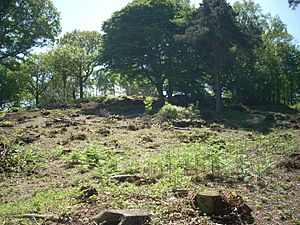Bigbury Camp facts for kids
Bigbury Camp is an ancient hill fort located in Kent, England. It's a special type of fort called a univallate hill fort, meaning it has one main defensive wall or ditch. This site is very important because it's the only confirmed Iron Age hill fort in eastern Kent. Today, the Kent Wildlife Trust looks after it.
People lived at Bigbury Camp starting around 350 BC. It's even thought that Roman soldiers, led by Julius Caesar, might have attacked this fort in 54 BC!
Contents
Where is Bigbury Camp?
Bigbury Camp is found on a hill about 3.2 kilometers (2 miles) west of Canterbury. You can find it on a smaller road between the A2 and A28 roads, just southwest of Harbledown. Two famous walking paths, the North Downs Way and the Pilgrims' Way, both cross through the site.
What Does the Fort Look Like?
The fort covers a large area, about 10.7 hectares (26.4 acres). This includes a northern part that's about 3.2 hectares (7.9 acres) and might have been used to keep cattle safe.
The fort has one main defensive ditch that is 4.8 meters (16 feet) wide. Inside this ditch, there's a raised bank, and outside it, there's a smaller bank. These defenses follow the natural shape of the hill, which is about 60 meters (197 feet) above sea level.
When archaeologists dug here in the 1960s, they found big holes in the bottom of the ditch. These holes suggest there was a strong wooden fence, called a palisade, running along the ditch to make it even harder to attack.
The fort had two ways to get in: one on the east side and one on the west. The east entrance is now crossed by a modern road. It was protected by a clever defense system with two ditches and a bank that were staggered.
What Was Found at Bigbury Camp?
Many archaeological studies have happened at Bigbury Camp. Digging has uncovered many iron objects, like tools for farming and things used in the kitchen.
In 1861, workers digging for gravel found some rusty iron pieces. These included parts of rods, rings, and hooks. They also found triangular bricks arranged in a circle, which showed signs of burning. Experts thought this was a Roman-style hearth, like a cooking stand, with three iron legs that held hooks and rings for hanging a cooking pot. This whole setup would have been about 1.5 meters (5 feet) tall. A flint arrowhead was found nearby too.
The gravel diggers also found a large iron knife, about 26.7 centimeters (10.5 inches) long, including its handle part. Pieces of a horse's bridle were also found, including a special bit for the horse's mouth with bridle rings that were 8.3 centimeters (3.25 inches) wide.
A very interesting discovery at Bigbury was a slave chain with its lock. This shows that there was a slave trade between Britain and Gaul (an area that is now mostly France) before the Romans arrived. Parts of an iron wheel rim and early Iron Age pottery were also found. All these finds together suggest that Bigbury had a successful farming community during the Iron Age. Later Iron Age finds include good quality pottery made on a potter's wheel.
Even with all the digging, no Iron Age coins have been found at Bigbury Camp. This has led some researchers to believe it wasn't a major permanent town. You can see some of the items found at Bigbury Camp in museums in Canterbury and Maidstone.
History of Bigbury Camp
Bigbury Camp was lived in for a long time during the Iron Age before the Romans came. People first settled here around 350 BC. However, the main ditch and bank defenses weren't built until the 2nd century BC.
It's very likely that Bigbury Camp was the British fort that was attacked by the Roman Seventh Legion in 54 BC. Julius Caesar wrote that the entrances to the fort were blocked with fallen trees. The site was abandoned around this time, possibly because of Caesar's attack. After this, the main settlement moved east to Canterbury, which seems to have been built to take its place.
Modern Discoveries
Archaeologists started digging at Bigbury Camp in 1933. During these early digs, they cut two large trenches across the northern part of the main defensive bank.
Images for kids




